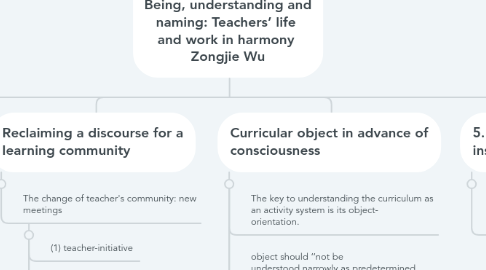
1. Part 1: Introduction:
1.1. 1. Background:
1.1.1. 1) Educational reform becomes a device of professional remodelling for the maintaining and extension of the system itself at the service of government and economic reproduction.
1.1.2. 2)A teacher only plays a tiny role in the giant assembly system of transmitting words.
1.1.3. 3)Teachers’ learning is reduced to knowing how to play this role efficiently and technically
1.2. 2. Key concepts in this paper
1.2.1. 1) Teachers’ life is conceived here as being led by the natural curiosity of knowing towards authenticity.
1.2.2. 2) Teachers’ understanding emerges from their authentic life in the nameless, and articulates itself with students in the form of ‘silent’ speaking or teaching.
1.2.3. 3) Naming is the language that brings understanding into interpretation and manifestation.
1.2.4. For Zongjie Wu, teaching as a spiritual encounter with students, not governed by ‘knowing that’ in terms of pedagogical knowledge, teaching principles and educational beliefs embodied in language. Rather it is a deep sense of unspoken understanding, detecting students’ horizon of learning
1.3. 3. The purpose of this paper is
1.3.1. to bring together such a philosophical elaboration of teaching in terms of being, understanding and naming, and empirical study of curriculum discourse.
1.4. 4. Methodology--A case study of a reform initiated by a group of teachers
2. Part 2: An overview of the curriculm systen in change
2.1. The dominant curriculum system before the innovation
2.1.1. 1) Subject (identity) :Teacher as curriculum implementer 2)Mediatinginstruments:Textbook/examination 3) Object -outcome: English language with emphasis on statements of knowledge (Subject boundaries sharp) -Examination scores -Communicative ability 4) Curriculum principles and institutional rules: Teacher centred (discipline/ individual/effort/) /Solution giving /Reward and punishment /public and ritualised / Top-down, imposed 5)Community: Boundary-sharp community /Explicit hierarchical structure /Teacher group insulated from each other 6) Division of labour : Knowledge transmitter /Course-contained /Duty assigned
2.1.2. The emerging curriculum system
2.1.2.1. 1) Subject (identity) :Teacher as curriculum constructor 2)Mediatinginstruments: Library/portfolio/poster/task/ topic 3) Object -outcome: Learner with emphasis on ways of knowing (Subject boundaries blurred) -Examination scores -Communicative ability 4) Curriculum principles and institutional rules: Learner centred (negotiate/ collaborate/interest) / Problem setting / Reward and punishment less public and ritualised / Bottom-up, collaborative 5) Community: Boundary-blurred community /Integrated and differentiated structure /Inter-dependent/ heterogeneous group 6) Division of labour : Resource manager / Problem determined/ Duty negotiated
3. Reclaiming a discourse for a learning community
3.1. The change of teacher's community: new meetings
3.1.1. (1) teacher-initiative
3.1.2. (2) informal way of discussion
3.1.3. (3) no explicit purpose
4. Curricular object in advance of consciousness
4.1. The key to understanding the curriculum as an activity system is its object- orientation.
4.2. object should ‘‘not be understood narrowly as predetermined, consciously fixed goal or objective’’. Rather the object is a cultural and collective construct
4.3. The knowledge of object manifest itself in the participants’ actions
4.4. From the example, the writer tries to how the curricular object in terms of a shifting from transmitting language knowledge for examination scores towards cultivating students for whole personal development manifested itself in advance of the teachers’ consciousness.
5. 5. Teacher understanding emerging from a novel instrument
5.1. Poster making: contains seven generic elements: title, picture, outline of oral presentation, vocabulary list, discussion question, biblio-graphy and group members’ names.
5.1.1. reshape teachers’ knowledge of curriculum practice.
5.1.1.1. Poster as a tool to show the students’ work
5.1.1.2. Poster as a tool to discipline students
5.1.1.3. Poster-making as an artistic craft
5.1.1.4. Poster as a task for digesting reading materials
5.1.1.5. Poster as a tool to facilitate collaborative learning
6. 6. Naming as bringing understanding to language
6.1. Wenger (1998, pp. 58–59) defines reification as ‘‘the process of giving form to our experience by producing objects that congeal this experience into ‘thingness’’’. He holds that reification was undertaken in conjunction with participation.
6.2. reificationb includes the following process
6.2.1. naming the project as RICH, scheduling project learning, writing papers for publication, writing a teachers’ manual, brainstorming objectives, making video-tapes, recording and transcribing classroom talk, writing teachers’ diaries, etc.

